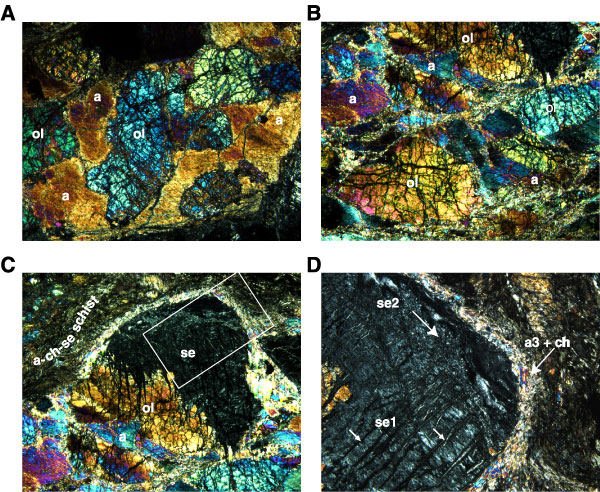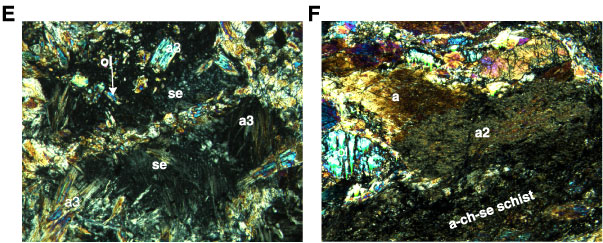
Figure F32. Photomicrographs showing deformation-metamorphism path in amphibole-bearing dunite as revealed by textural observations (Sample 209-1271B-12R-1, 126–131 cm) (cross-polarized light: blue filter). A. Coarse-grained aggregate of subhedral olivine (ol) showing smooth, curved boundaries with interstitial amphibole (a). Continuous extinction of the interstitial amphibole indicates that it is a single crystal. The smooth grain boundaries suggest textural equilibrium with olivine. This is the earliest generation of amphibole that could be defined on a textural basis in this rock type (field of view [FOV] = 5.5 mm; image 1271B_087). B. The olivine-amphibole aggregates locally experienced ductile deformation. Evidence for ductile deformation in amphibole includes wavy extinction of large porphyroclasts that are surrounded by a mantle of amphibole neoblasts. These textures indicate a high-temperature ductile deformation of amphibole-bearing dunite aggregates (FOV = 5.5 mm; image 1271B_088). C. Coarse olivine (ol) and proto-amphibole (a) are replaced along a band consisting of fine-grained amphibole-chlorite-serpentine schist (a-ch-se) in a brittle microshear band. This shear band is subparallel to the ductile deformation plane defined by elongated amphibole porphyroclasts (a). Olivine is transformed to serpentine (se) along cracks that do not crosscut the shear band. These textural relationships suggest a retrograde breakdown of olivine under greenschist facies conditions coeval with the development of the amphibole-chlorite-serpentine schist (FOV = 5.5 mm; image 1271B_089). White rectangle is the outline of the enlargement shown in D. D. Detail of photomicrograph shown in C (white rectangle) illustrating the development of different serpentine textures. A fibrous and interlocking serpentine texture (se1) is generated along cracks (red arrows). This serpentine texture is overprinted by a second generation of banded serpentine (se2) subparallel to the schistosity defined by the amphibole-chlorite-serpentine band. The se2 texture is in turn replaced by a corona of fine-grained amphibole-chlorite (a3 + ch) in the contact with the amphibole-chlorite-serpentine schist (FOV = 2.75 mm; image 1271B_090).
E. Interlocking serpentine texture (se) after olivine (ol)
breakdown is replaced by fine-grained amphibole (a3) growing topotactically in
serpentine (FOV = 1.4 mm; image 1271B_091). F. Retrograde
breakdown of high-temperature amphibole porphyroclast (a) to a later fibrous
amphibole (a2) along an amphibole-chlorite-serpentine (a-ch-se) microshear band.
Note that fibers of the secondary amphibole are oriented parallel with respect
to the schistouos band suggesting a retrograde synkinematic formation under
greenschist facies conditions (FOV = 2.75 mm; image 1271B_092).





![]()